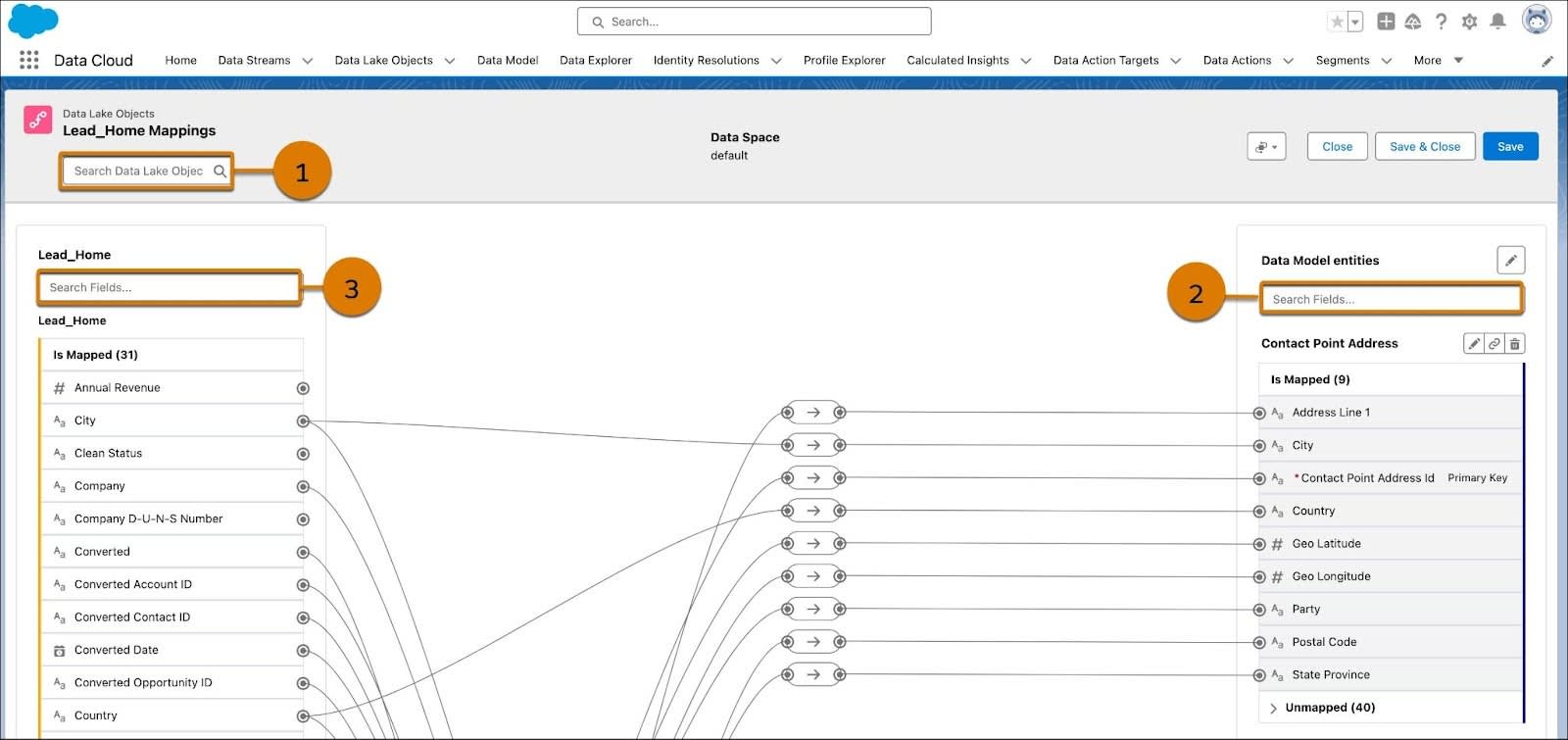Add and Map a Formula Field
Map Your Field to a Data Model Object
Data Cloud has a lot of cool capabilities (such as identity resolution, segmentation, and creating calculated insights). And to use these, you first need to map your ingested data to data model objects (DMOs). When using Salesforce standard data bundles like we’re doing in this project, some standard data objects are pre-mapped for you. Since you added a new custom formula field (and often businesses have other standard and custom objects in their data sources), these fields need to be manually mapped to the Customer 360 Data Model. Map those unmapped fields!
- Click the Data Streams tab and then select the data stream, Lead_Home.
- From the Data Mapping section, click Review.
On one side of the screen are the searchable (1) Data Lake Objects (DLOs). On the other side, are the searchable (2) DMOs (called Data Model entities in-app). To search for a field within a DLO use the DLO search bar (3) in this case, Lead_Home.

We need to create a new DMO field and then map it to our new formula field.
- Under Data Model entities, scroll to the Lead section and under Unmapped, click Add New Field. (You may need to scroll down to the Lead section to find the unmapped category!)

- Name the Field,
Is US Basedand select Text as the Data Type.
- Click Save.
- Now under the Data Lake Object, Lead_Home, search for the unmapped field Is US Based.
- Select Is US Based until highlighted and then under Data Model entities, scroll to the Lead section and under Unmapped select the newly created Is US Based custom field.
- After a line is drawn to connect the two fields, click Save.
Now let’s map a few other fields from the Lead_Home DLO that haven’t been mapped yet.
- Under the Lead_Home DLO search box, search for the field Industry and click it.
- Under Data Model entities, search for Industry. You’ll find it in the Lead section.
- Map the two together by clicking on the DLO, then on the DMO.
- After a line is drawn to connect the two fields, click Save.
- Now locate Phone under the Lead_Home search box. Notice it is already mapped to Telephone Number. We also need to map it to Formatted E164 Phone Number.
- Click on Phone to select it and then locate Formatted E164 Phone Number from the Unmapped section of Contact Point Phone.
- Select Formatted E164 Phone Number.
- After a line is drawn to connect the two fields, click Save & Close.
Prep for Identity Resolution
To unify profiles with Identity Resolution, some additional fields are required to be mapped. Map those fields.
- From Data Streams, select the Contact_Home data stream.
- Under Data Mapping, click Review.
- Following similar steps to above, map Business Phone from the Contact_Home DLO to Formatted E164 Phone Number under the Contact Point Phone entity.
- Click Save & Close.
Follow these steps for the Account data stream.
- From Data Streams go to the Account_Home data stream.
- Map Account ID to Party under the Contact Point Address entity.
- Map Account ID to Party under the Contact Point Phone entity.
- Map Account Phone to Formatted E164 Phone Number under the Contact Point Phone entity.
- Once done, click Save & Close.
Verify Your Work
Verify your work by clicking on the button in the challenge section below. This will check to see that you’ve created a custom DMO field, mapped it to your new formula field, and mapped the Industry field to the correct DMO.
What’s Next?
Whether you want to unify data, create insights, expand AI models, visualize all your data, or just act on that data anywhere you dream up—creating a data stream is step one. And with this project complete, your journey with Data Cloud can truly begin. So what’s next in your journey?
-
View Your Data. With Data Explorer, you can view data lake objects (DLOs), data models objects (DMOs), or calculated insight objects (CIOs).
-
Learn More. Visit the Help page, Data Cloud Resources, to find Data Cloud videos, Trailhead modules, blogs, and more.
-
Explore Data Cloud. Use the Developer org to explore the Data Cloud interface and product functionality.
Continue practicing Data Cloud skills in the next project Quick Start: Create an Identity Resolution Ruleset.
Resources
- Salesforce Help: Data Cloud Resources
- Salesforce Help: View Your Data in Data Explorer
- Salesforce Help: Data Mapping